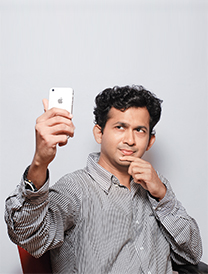 When a word enters the Oxford Dictionary, it suddenly makes people wake up. The word ‘selfie’ has been defined as a photograph that one has taken oneself, typically with a Smartphone or a webcam, and updated to a social media website. However, selfies taken with digital cameras also qualify under this definition.
When a word enters the Oxford Dictionary, it suddenly makes people wake up. The word ‘selfie’ has been defined as a photograph that one has taken oneself, typically with a Smartphone or a webcam, and updated to a social media website. However, selfies taken with digital cameras also qualify under this definition.
Why have selfies suddenly drawn so much attention? Why do they get mentioned so often in the popular press? The answer is that Smartphone companies have incredible marketing budgets and love to create a lot of excitement and anything that can catch a person’s attention is blown up and given unparalleled publicity. A selfie is actually a self portrait and it is possible to take this either on a D-SLR or compact digital camera – the only feature that was a must was a tilt and swivel viewfinder. Smartphone manufacturers quickly caught on to this idea and started incorporating front and rear cameras in their Smartphones. It therefore became possible to take a self-picture using the front camera and through the help of features on the Smartphone, transmit it to the website of your choice.
How good are the selfies taken in this manner? One must remember that a selfie is taken with your arm extended and therefore the camera is likely to be 2 to 3 feet away from the subject. This requires a high quality lens that can focus at close distances without visible distortion. Not all Smartphones can promise you such a high quality lens; with the result, a lot of selfies are of poor or mediocre quality. On the positive side, a selfie obviates the need of having to ask someone else to click your own picture. Again, camera shake is very common when you click with your arm extended and the best image stabilization systems would struggle to cope with it.
The American Psychiatric Association has officially confirmed that taking selfies is a mental disorder. There are also several claims that selfies cause narcissism, addiction and several other mental illnesses.
H. S. Billimoria

